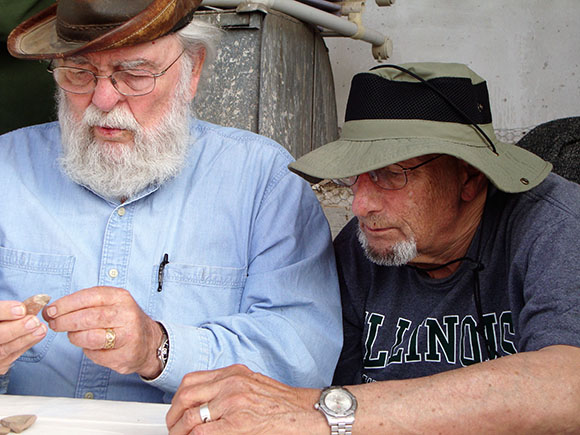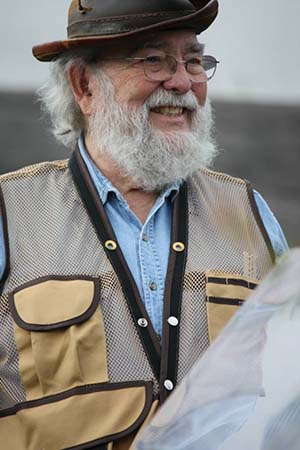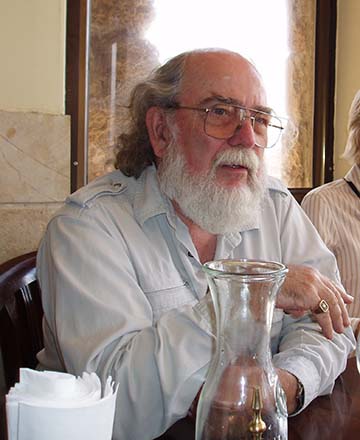
IN MEMORIAM—JAMES F. STRANGE (1938–2018)
Jim Strange (“Abuna” to the Arabs and to many of us who wanted to honor his Baptist ordination with the Arabic version, “Father”) was the consummate ASOR field archaeologist. He could do things in the field few people in our professional history could do. We can continue to read his voluminous publications, watch him lecture in his various videos and recorded series, visit places now on display where he directed the excavations; but sadly we will never see again the magic he could work as the most skilled field person I have ever seen in scientifically and “artistically” teasing an ancient site into being again—a man whose archaeological gifts made him the perfect choice to be “present at the recreation” of a piece of Roman or Late Roman antiquity.
After years of digging with, and under Jim, first as part of Eric M. Meyers and Jim’s Meiron Excavation Project in the Upper Galilee, and then as one of Jim’s Associate Directors for many years at The USF Excavations at Sepphoris, I know something of the golden skills that have been lost to us and to future generations as we watched him working in the field.

Jim Strange (left) and Denny Groh reading pottery
After decades of bringing my graduate-professional and Northwestern Ph.D. students to learn and excavate on Jim’s projects, I spent my last ten years at another of my alma maters, Illinois Wesleyan University. When I brought a large group of undergraduate students to Sepphoris in 1997 and they got a look at Jim in the field for the first time in all his digging gear, they came over to me and asked me: “Are you really an archaeologist.” Answering in the affirmative, they demurred and pointed at Jim in his hat and many-pocketed vest, shirt, and trousers (see photo) and said: “he’s an archaeologist. Look at his outfit. You don‘t even have an outfit like that.” I explained that Jim’s appearance was his own look and the outfit allowed him to have both hands free when he needed it and to produce the proper tool from his pockets when needed. I carried a leather shoulder bag (likely because my first teacher in stratigraphy, the great Larry Toombs did). They sniffed their disbelief in my capacity and walked away, still fixated on Jim.
Actually, my students discerned correctly how remarkable Jim was. Well, we need to say goodbye to that palpable Jim and talk about some of his extraordinary gifts.
Jim brought to the field and to 
As the adopted son of Jerry Donald “Rip” Strange, from an early age Jim grew up with a thorough knowledge of surveying and drawing-to-scale. The architect of a sister excavation at Sepphoris came by one day to explain to Jim that the elevations of our structure did not match with theirs, and Jim needed to correct his. Jim looked at his drawings and said “I think you are about a half a meter off.” After looking at our plans, the architect asked if he could borrow them and went off to correct his drawings.
As for his ability to draw balk, I witnessed Jim do something I didn’t think was possible when we excavated the Gush Halav synagogue in Upper Galilee. Eric Meyers, Jim, and Carol Meyers decided to excavate the opposite corners of the interior quadrant of the synagogue structure, leaving a continuous N/S, E/W balk across the entire synagogue. But because the squares are on opposite sides of the structure, one balk can be drawn straightforwardly as a regular balk to be drawn exactly as seen; but the continuation of the N/S and E/West balks appear to the drawer who is now looking the opposite direction at the second half of the balk. Thus, for example, the drawer can start drawing the N/S balk facing West; but the second half of that balk has to be drawn looking East because the SW quadrant facing that balk has to be viewed from the West [See,Meiron Excavation Project V, Eric M. Meyers, Carol . Meyers, with James F. Strange (Eisenbraums, 1990), p. 5, Fig. 4, paying attention to squares I.4 and I.3; and pp. 29-30, Figs. 5 and 6.]. Whoever draws second half of the continuous balk had to draw it backwards on the section since the archaeologist was looking at the back side of the second half of the section. If you think what I have just written is impossible to understand, get at least this much: half of the N/S and E/W sections that bisected the synagogue to create continuous balks had to be drawn to scale backwards. Who but Jim Strange could perform such an impossible task of backward balk drawing? So he did it.
Daily pottery reading is a must for excavators who want to know in exactly what time-period or kind of space (domestic, commercial, etc.) they are digging as their excavation proceeds. It is a must for most American excavators; and Jim and I did such field-reading together, off-and-on, for forty years. When we had a special season for publication of the structures on the acropolis at Sepphoris, it was required that we open and re-check the field readings of all the critical loci. Field readings are done quickly and on a first or second glance and handling of the pottery, so at the end of digging a field or structure, it is imperative that the first readings be rechecked. We were both surprised and gratified to conclude after opening and re-checking the sherds in every critical locus bag, that only one locus required a slight adjustment in dating.

Jim Strange
Granted that we both know our pottery identification. But the above level of accuracy in field-reading is as much due to how well the readers see and spot the sherds poured out on the table. And our exactitude, I believe, was as much due to Jim’s far seeing and closely discriminating eyes (look at the picture close-up of Jim at lunch at Caesarea and note his eyes). That means Jim had an extraordinary ability to record any even subtle visual changes in normally repetitive mundane objects or even places that we might see every day.
So it was that Jim, Tom, and I were coming down the hill that leads from the Acropolis at Sepphoris to the flat lot where the buses are parked every day. Jim suddenly noticed a couple of weeds that previously had never appeared on that spot and said “look how ‘peaky’ those weeds are.” Well, we said, it is the “dry” season. Jim replied “yes, but we aren’t deep enough into that season that the plants should get no water, unless . . .” And we all said “there’s something directly under the surface keeping the water out.”
Out from behind Jim’s Harry Potter vest comes his trowel, and he begins to scrape the surface. What Jim uncovers in a couple of minutes is the base of a sweetheart column and a wall attached to it. Before we are done chasing that (in several seasons) the huge Field V public basilica has appeared, festooned with lovely mosaics. Ah . . . how we shall miss those restless, unequivocating eyes!
Jim was able to use many of his extraordinary gifts almost until he died. A great man has left us. But frankly some of the young ASOR archaeologists I have seen look pretty good. If they could set themselves to attaining Jim Strange’s levels of expertise, we would still miss Jim. Yet, Jim always looked to the future and to the training of new archaeologists for better clarity and more answers. I think such a new generation would make him very happy indeed.
Dennis E. Groh, Ph.D.
University Chaplain Emeritus
Professor of Humanities and Archaeology (ret.)
Illinois Wesleyan University
Easter Sunday
April 1, 2018